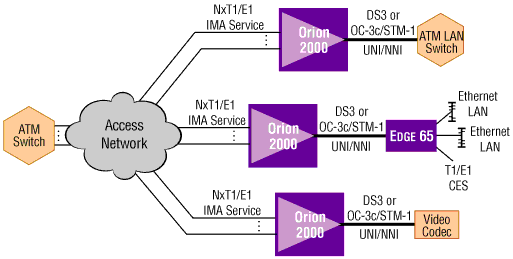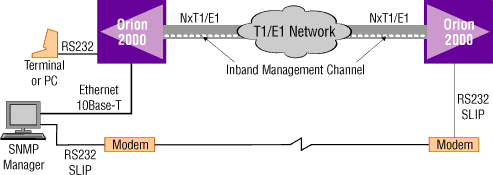

Benefits
Larscom's Orion 2000™ IMA Inverse Multiplexers for ATM offer ATM connectivity up to 12 Mbps over T1 lines, or up to 16 Mbps over E1 lines. Orion 2000 is ideal for applications where higher-rate ATM WAN connections (DS3 or OC-3c) are either unavailable or cost-prohibitive. Designed and built to Central Office standards, Orion 2000 is equally suited to private ATM LAN interconnection, and to deployment by Network Service Providers for customer premises equipment, switch-to-switch trunking, or voice/video transport. Orion 2000 transports ATM cells between an OC-3c/STM-1 or DS3 UNI/NNI, and a WAN channel created from up to eight T1s or E1s, in full conformance with the ATM Forum's IMA Specification. To optimize traffic management between the UNI/NNI (45 or 155 Mbps) and the T1 or E1 IMA channel, Orion 2000 includes four separate queues to prioritize and buffer a total of 16,384 cells. Sizes and thresholds for three of the queues, plus discard and congestion-management options, are user-configurable for optimal performance in a range of applications.
Sophisticated ASCII terminal and SNMP management interfaces allow local or remote configuration, performance monitoring, alarm notification, and diagnostic testing. In addition, an optional LarsView 2000 GUI offers graphical, point-and-click monitoring and control.
The basic function of Orion 2000 is to interconnect ATM devices point-to-point across a wide area using multiple T1/E1 lines. Virtually any pair of ATM devices (e.g., routers, switches, hubs, workstations) can be interconnected, as long as each has a DS3 or OC-3c/ STM-1 UNI/NNI port. Use of inverse-multiplexed T1s or E1s for the WAN link provides major cost and availability benefits over DS3 or OC-3c/ STM-1 ATM WAN links.

Multi-Service IMA Applications
For NSPs offering native ATM service, Orion 2000 presents a combination of quality, features, price, and size that makes it ideal for deployment as CPE at customer sites. Bandwidth can be configured for individual customers' needs, then easily adjusted as those needs evolve. SNMP and terminal interfaces provide the manageability required by NSPs--including remote/ local configuration, extensive performance monitoring and alarm options, and built-in diagnostics.
Deploying Larscom's Edge Multi-service Access Concentrators with Orion 2000 allows an NSP to provide managed network services such as Transparent LAN Service (TLS), VPN, and ExtraNet.

An SNMP manager can connect to a local Orion 2000 via Ethernet 10Base-T, and to a remote Orion 2000 using an inband Telnet connection or external modem and SLIP. A terminal interface allows menu-driven management from ASCII terminals and PCs over local or remote RS232 connections, as well as via Telnet. A LarsView 2000 GUI is also available for graphical, point-and-click management.

Inverse multiplexing for ATM (IMA) is a method specified by the ATM Forum for transporting ATM cells across a group of T1 or E1 lines. Developed as an alternative to DS3 or OC-3c/STM-1 ATM links, IMA provides fractional DS3/E3 bandwidth, with considerable cost savings as well as much wider availability. IMA also facilitates the interoperability of different vendors' equipment, increasing the options for network design and evolution.
Orion 2000 supports an OC-3c/STM-1 or DS3 UNI/NNI to a local ATM device, and a WAN channel comprised of up to eight inverse-multiplexed T1s or E1s. A common or independent transmit clock (CTC or ITC) can be specified, enabling non-synchronous or synchronous mode.
The rate differential between the DS3 or OC-3c UNI/NNI and the IMA channel makes buffering and traffic management supremely important. ATM traffic is by nature "bursty", so the ability to handle high-rate bursts can make up for a large disparity in bandwidth across an ATM path.
Orion 2000 provides an exceptionally large, 1 Megabyte buffer divided into four queues. These queues, which hold a total of 16,384 cells, allow users to tailor cell buffering to particular applications and traffic mixes. A 1,024-cell "reserved" queue is dedicated to signaling and ILMI cells, with discard occurring only on buffer overflow.
The other three queues--for CBR, VBR, and UBR (data) traffic--are independently configured by the user in 1,024-cell increments.
Discard conditions and thresholds for the CBR, VBR, and UBR queues are also user-specified. Thresholds for dropping cells and resuming buffer input can be set to any one-eighth increment of the buffer size. Cells can be discarded based on CLP marking, or Early Packet Discard (EPD) can be enabled for AAL5 frames.
To aid in congestion management, Orion 2000 supports Explicit Forward Congestion Indication (EFCI). Constant bit rate (CBR) traffic, such as real-time video, benefits from Orion 2000's very low cell delay variation.
Centralized Network Management
Manageability of network equipment is a major concern in both private and service-provider networks--and a high level of manageability is built into Orion 2000. Management ports include two RS232 ports and one 10Base-T Ethernet port. In addition, a user-specified VPI/VCI can be defined as an end-to-end management link in the IMA channel. For flexibility, Orion 2000 includes common tools such as Telnet and TFTP.
Orion 2000 provides full SNMP and terminal interfaces, plus an optional LarsView 2000 Graphical User Interface (GUI). The SNMP Agent supports standard DS1/E1, DS3, and IMA MIBs, and Larscom extensions.
The easy-to-use terminal interface features menus and pop-up windows. It supports local and remote connections, including automatic dialout, and provides access to all of Orion 2000's extensive configuration, performance management, and diagnostic functions.
Performance Monitoring and Diagnostics
Orion 2000 monitors unit, cell, T1/E1, and DS3/OC-3c/STM-1 parameters full-time, giving you a detailed picture of performance at all levels. User-selected alarms notify you of critical problems, while numerous 15-minute and 24-hour registers provide the historical data you need for trouble analysis, documentation, and trending. To aid in problem isolation, Orion 2000 implements a range of T1/E1, UNI/NNI, and cell loopbacks--as well as the IMA pattern sync test.
| Line Interfaces | |
|
T1 |
4 or 8 lines; per AT&T PUB 62411; DB15 male connectors; 0, -7.5, or -15 dBm LBO; 1.544 Mbps ±32 ppm; B8ZS or AMI; ESF per AT&T PUB 54016, ANSI T1.403 |
|
E1 |
4 or 8 lines; balanced 120 ohm per ATM Forum E1 Physical Interface specification; DB15 male connectors; 2.048 Mbps ±50 ppm; HDB3; with or without CRC |
|
Inverse Multiplexing Mode |
Cell-based per ATM Forum IMA Specification 1.1, April 1998 |
|
T1/E1 Alignment |
1 to 8 T1s or E1s; 1 ATM link group; ITC or CTC mode |
|
Differential Delay |
T1: 0 to 125 ms; E1: 0 to 100 ms |
| ATM Port | |
|
DS3 |
DS3 UNI or NNI per ATM Forum (44.736 Mbps ±20 ppm); internal and loop clocking; PLCP or HEC framing; B3ZS coding; C-bit parity; 75-ohm BNC connectors (DSX-3-3 per ANSI T1.404) |
|
OC-3c |
OC-3c/STM-1 multimode fiber UNI or NNI per ATM Forum (155.52 Mbps ±20 ppm, 1270 to 1380 nm); internal and loop clocking; SC duplex connector; -14.0 to -20.0 dBm transmit power; -14.0 to -29.0 dBm receive sensitivity; payload scrambling |
|
Traffic Prioritization |
16,384 cells total; 4 queues; 3 configurable queues for CBR, VBR, and UBR traffic |
|
Congestion Management |
User-defined discard on queue thresholds, CLP-marked cells, EPD for AAL-5; EFCI |
| Management | |
|
Access |
Two RS232 ports (ASCII, 1200 to 38,400 baud; DB-9 male DTE, SLIP); one Ethernet port (IEEE 802.3 10Base-T, RJ45); user-specified VPI/VCI (optional) |
|
Modes |
SNMP, Telnet, and TFTP; menu-based ASCII interface |
|
SNMP MIBs |
MIB II, DS1/E1, and DS3 (RFCs 1213, 1406, 1407); IMA (SNMP V1); Larscom MIBs |
| Monitoring & Diagnostics | |
|
Self-Test |
Basic diagnostics at power-up or restart; Ping and SNMP Trap by user command |
|
Performance Monitoring |
24-hour registers for T1 or E1 (G.804), IMA, and UNI parameters. User-configurable alarms on unit, T1/E1, IMA, and UNI performance parameters |
|
Loopbacks |
Local and remote T1/E1, DS3/OC-3c, and cell loops |
| Miscellaneous | |
|
Power |
Auto-ranging 100/240 V ac, or -48 V dc office battery; typically consumes 25 watts |
|
Dimensions |
3.5 x 17 x 12.5 inches (8.8 x 43.2 x 31.8 cm); brackets for 19- or 23-inch rack |
|
Environment |
32 to 113 ¡F (0 to 50 ¡C); up to 80% relative humidity, Noncondensing |
|
RS232 Ports |
Two rear-panel RS232 ASCII, 1200 to 38,400 baud; DB-9P (EIA574) male connectors configured as DTE; SLIP capability (for SNMP, Telnet, and TFTP) |
|
Ethernet Port |
IEEE 802.3 10Base-T RJ45 connector (for SNMP, Telnet, and TFTP) |
|
Regulatory Compliance |
FCC Parts 15 & 68; UL
1950; EN60950; EN55022 (Class A); EN50082-1 The CE marking on the product certifies that it complies with all applicable and necessary EU directives |